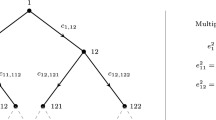Abstract
Evolution algebras are non-associative algebras. In this work we provide an extension of this class of algebras, in a framework of Hilbert spaces, and illustrate the applicability of our approach by discussing a connection with discrete-time Markov chains with infinite countable state space. Specifically, if we associate to each possible state of such a Markov process a generator of the Hilbert evolution algebra structure, then the whole dynamics of the process can be described through consecutive applications of the evolution operator, provided certain boundedness conditions on the transition probabilities hold.


Similar content being viewed by others
References
Cadavid, P., Rodiño Montoya, M. L., & Rodriguez, P. M. (2020). The connection between evolution algebras, random walks, and graphs. J. Algebra Appl. 19(2), 2050023.
Cadavid, P., Rodiño Montoya, M. L., & Rodriguez, P. M. (2021). On the isomorphisms between evolution algebras of graphs and random walks. Linear Multilinear Algebra 69(10), 1858–1877.
Cadavid, P., Rodiño Montoya, M. L., & Rodriguez, P. M. (2020). Characterization theorems for the space of derivations of evolution algebras associated to graphs. Linear Multilinear Algebra 68(7), 1340-1354.
Cabrera Casado, Y., Cadavid, P., Rodiño Montoya, M. L., & Rodriguez, P. M. (2021). On the characterization of the space of derivations in evolution algebras. Annali di Matematica. 200, 737-755.
Cabrera, Y., Siles, M., & Velasco, M. V. (2016). Evolution algebras of arbitrary dimension and their decomposition. Linear Algebra Appl. 495, 122-162.
Camacho, L. M., Gómez, J. R., Omirov, B. A., & Turdibaev, R. M. (2013). Some properties of evolution algebras. Bull. Korean Math. Soc. 50(5), 1481-1494.
Casas, J. M., Ladra, M., Omirov, B.A., & Rozikov, U.A. (2014). On Evolution Algebras, Algebra Colloq. 21, 331.
Elduque A., & Labra, A. (2015). Evolution algebras and graphs. J. Algebra Appl. 14, 1550103.
Elduque A., & Labra, A. (2016). On nilpotent evolution algebras. Linear Algebra Appl. 505, 11-31.
Falcón, O.J., Falcón, R.M., & Núñez, J. (2017). Classification of asexual diploid organisms by means of strongly isotopic evolution algebras defined over any field. J. Algebra 472, 573-593.
Halmos, P.R. (2012). A Hilbert space problem book, Vol. 19, Springer Science and Business Media.
Heil, C. (2019). Introduction to Real Analysis, Vol. 280, Springer.
Labra, A., Ladra, M., & Rozikov, U. A. (2014). An evolution algebra in population genetics. Linear Algebra Appl. 457, 348-362.
Mellon, P., & Velasco, V. (2019). Analytic aspects of evolution algebras. Banach J. Math. Anal. 13(1), 113-132.
Reis. T., & Cadavid, P. (2020). Derivations of evolution algebras associated to graphs over a field of any characteristic. Linear Multilinear Algebra. Advance online publication. https://doi.org/10.1080/03081087.2020.1818673
Ross, S. M. (2010). Introduction to Probability Models, 10th Ed., Academic Press.
J. P. Tian, Evolution algebras and their applications, Springer-Verlag Berlin Heidelberg, 2008.
Tian, J. P., & Vojtechovsky, P. (2006). Mathematical concepts of evolution algebras in non-Mendelian genetics. Quasigroups Related Systems 1(14) , 111-122.
Acknowledgements
Part of this work was carried out during a visit of P.C. at the Universidade Federal de Pernambuco (UFPE); and visits of P.M.R. at the Universidade Federal do ABC (UFABC) and at the Universidad Nacional de la Patagonia “San Juan Bosco” (UNPSJB). The visit at UNPSJB was during the realization of the School EMALCA 2019. The authors are grateful with these institutions, and with the organizers of the School, for their hospitality and support. Part of this work has been supported by Fundação de Amparo á Pesquisa do Estado de São Paulo-FAPESP (Grant 2017/10555-0).
Author information
Authors and Affiliations
Corresponding author
Additional information
Communicated by Rahul Roy.
Rights and permissions
Springer Nature or its licensor holds exclusive rights to this article under a publishing agreement with the author(s) or other rightsholder(s); author self-archiving of the accepted manuscript version of this article is solely governed by the terms of such publishing agreement and applicable law.
Springer Nature or its licensor holds exclusive rights to this article under a publishing agreement with the author(s) or other rightsholder(s); author self-archiving of the accepted manuscript version of this article is solely governed by the terms of such publishing agreement and applicable law.
About this article
Cite this article
Vidal, S.J., Cadavid, P. & Rodriguez, P.M. Hilbert evolution algebras and its connection with discrete-time Markov chains. Indian J Pure Appl Math 54, 883–894 (2023). https://doi.org/10.1007/s13226-022-00304-y
Received:
Accepted:
Published:
Issue Date:
DOI: https://doi.org/10.1007/s13226-022-00304-y




